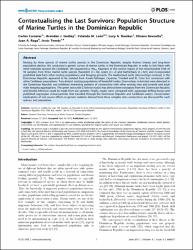Contextualising the last survivors : population structure of marine turtles in the Dominican Republic
| License | This is an open-access article distributed under the terms of the Creative Commons Attribution License, which permits unrestricted use, distribution, and reproduction in any medium, provided the original author and source are credited. | es |
| Author | Carreras, Carlos | |
| Author | Godley, Brendan J. | |
| Author | León, Yolanda M. | |
| Author | Hawkes, Lucy A. | |
| Author | Revuelta, Ohiana | |
| Author | Raga, Juan A. | |
| Author | Tomás, Jesús | |
| Accessioned date | 2022-05-31T01:27:39Z | |
| Available date | 2022-05-31T01:27:39Z | |
| Year | 2013 | |
| Citation | Carreras, C., Godley, B. J., León, Y. M., Hawkes, L. A., Revuelta, O., Raga, J. A., & Tomás, J. (2013). Contextualising the last survivors: population structure of marine turtles in the Dominican Republic. PloS one, 8(6), e66037. Recuperado de: | es |
| URI | https://bvearmb.do/handle/123456789/1007 | |
| Abstract | Nesting by three species of marine turtles persists in the Dominican Republic, despite historic threats and long-term population decline. We conducted a genetic survey of marine turtles in the Dominican Republic in order to link them with other rookeries around the Caribbean. We sequenced a 740bp fragment of the control region of the mitochondrial DNA of 92 samples from three marine turtle species [hawksbill (n = 48), green (n = 2) and leatherback (n = 42)], and incorporated published data from other nesting populations and foraging grounds. The leatherback turtle (Dermochelys coriacea) in the Dominican Republic appeared to be isolated from Awala-Yalimapo, Cayenne, Trinidad and St. Croix but connected with other Caribbean populations. Two distinct nesting populations of hawksbill turtles (Eremochelys imbricata) were detected in the Dominican Republic and exhibited interesting patterns of connectivity with other nesting sites and juvenile and adult male foraging aggregations. The green sea turtle (Chelonia mydas) has almost been extirpated from the Dominican Republic and limited inference could be made from our samples. Finally, results were compared with Lagrangian drifting buoys and published Lagrangian virtual particles that travelled through the Dominican Republic and Caribbean waters. Conservation implications of sink-source effects or genetic isolation derived from these complex inter-connections are discussed for each species and population. | es |
| Language | English | es |
| Published | PLoS ONE [1932-6203], 8(6), e66037. | es |
| Rights | 2013 Carreras et al. | es |
| Rights URI | https://creativecommons.org/licenses/by/4.0/ | es |
| Subject | Biodiversidad - República Dominicana | es |
| Subject | Hábitats y especies | es |
| Subject | Fauna ─ República Dominicana | es |
| Subject | Especies amenazadas | es |
| Title | Contextualising the last survivors : population structure of marine turtles in the Dominican Republic | es |
| dc.identifier.doi | 10.1371/journal.pone.0066037 | |
| Material type | Article | es |
| Type of content | Scientific research | es |
| Access | Open | es |
| Audience | Technicians, professionals and scientists | es |
Files in this item
This item appears in the following Collection(s)
-
Investigación ambiental [1693]
Access and downloading this document are subject to this license: This is an open-access article distributed under the terms of the Creative Commons Attribution License, which permits unrestricted use, distribution, and reproduction in any medium, provided the original author and source are credited.
2013 Carreras et al.
2013 Carreras et al.


